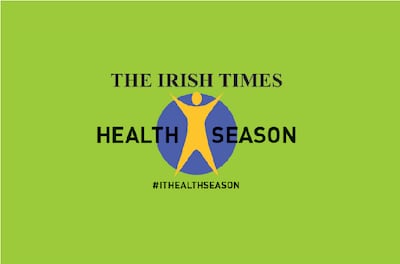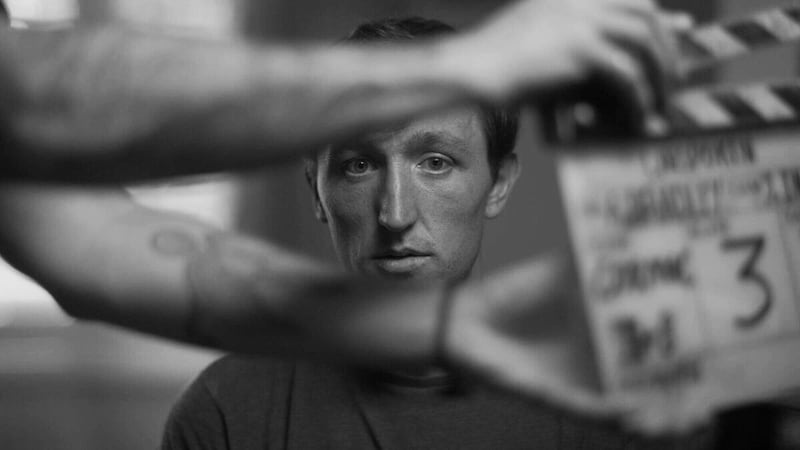
While eating disorders are often associated with girls and women, the reality is that an eating disorder can affect anyone. Accepting there’s an issue and seeking help, however, can prove more challenging for boys and men, particularly when coping with the stigma.
Podcaster Keith Russell says it was only when he enrolled in lifesaving classes as a teen, that he began to become very self-aware about how he looked.
“The lifesaving classes – you’re getting in and out of the water and you’re standing on the side of the pool,” he explains. “The guys couldn’t wear shorts. The guys could only wear speedos, that’s what we were told, and I just wasn’t comfortable. I started to get very anxious about being there. I’d be nearly worrying about it all week long. As the years went on, I just got worse and worse and I’d go home crying in the evening and the anxiety just turned into depression.
I would put on a few stone by emotional eating and then I would feel even worse. So I would start trying to restrict the food and start killing myself on the treadmill
“I started to not like myself and this is where the food stuff started. I felt I had this spare tyre around my waist and it probably wasn’t even much, but I felt it was there. I started to tell myself all these things I didn’t like about myself. I didn’t like my wrists. I didn’t like my jawline. I didn’t like my hairline. I didn’t like my stomach. I didn’t like my shoulders.”
Keith sought counselling for depression, but never “really linked anything together”.
“When I was in counselling for depression we never spoke about stuff like that. Because you’re a guy, you just get on with things and sweep things under the rug. Things just got worse and worse. Because I couldn’t change my jawline, or the birthmark on my ear, I started to really focus on the things I could change – the spare tyre around my waist.”
Keith’s self-consciousness meant he found working out at the gym very stressful and felt worse after than before. “I felt I wasn’t getting anywhere and that’s when the food stuff started. I restricted food a little bit but for me it was more the binge eating. Because I was feeling so bad about myself I would just turn to food, so my weight would balloon up and down. I would put on a few stone by emotional eating and then I would feel even worse. So I would start trying to restrict the food and start killing myself on the treadmill.”
It was only last year, when Keith discovered the term body dysmorphia, that he realised he’d been living with the condition for more than 20 years.

Lockdown was incredibly challenging and he started to blog about his experiences and feelings to help him cope. Others who had experienced the same thing began to contact him, ultimately leading to Keith raising the issues of body dysmorphia and eating disorders with his therapist.
Having only sought support for his eating disorder in the past year, Keith says he’s still trying to come to terms with it all. “Because the waiting lists are so long, I haven’t really had any help, so I’ve had to pay for things myself. But because they’re so expensive I’ve been restricted in what help I got. I’ve got three small kids, I don’t have the funds to pay for everything myself all the time.
“It’s a daily struggle with me. Body dysmorphia has stopped me doing everything. It’s stopped me going out with my friends . . . recently I didn’t want to go bowling because I didn’t want to lean forward to throw the ball down the lane. I don’t like bringing my kids to swimming in case I have to get in. I don’t want to be on show. It has stopped me doing so many things, I’ve lost so many years of my life, so many memories that I could have made.”
In spite of the daily struggle, Keith says he’s doing much better than he was. His wife, Karina, who he hid his eating disorder from for a long time has been his “rock”.
“She’s a great sounding board and she looked after me. She’s been absolutely amazing and I wouldn’t be here without her.”
Ellen Jennings, communications officer at Bodywhys – the national voluntary organisation supporting people with eating disorders and their families – says an eating disorder can affect anyone at any stage, but for men there's a stigma around eating disorders being a female issue, and that results in a double stigma.
“Eating disorders in men are underdiagnosed and undertreated and it can take them longer to recognise there’s a problem. And when there’s a delay, the issue can become more entrenched. More men come forward at a stage where they’re so physically unwell that they might require more intense treatment.
The media and social media have to take responsibility for what they're putting out there
“From March to September 2020, 40 per cent of hospital admissions for eating disorders were male,” Ellen says. “The pandemic, that’s really the epitome of things being out of control – that uncertainty, the loss of routine and the usual coping methods that people had were all taken away by the pandemic and being thrust into that online environment.”
The media and social media have to take responsibility for “what they’re putting out there”, Ellen says, but cautions that the causes of eating disorders “are multiple and complex”.
For those concerned they may have an eating disorder, or for family and friends who may be concerned a loved one has an eating disorder, Ellen advises remembering to “distinguish the person from the eating disorder. Listen to their feelings without judgement. The first step is to try and open up about it, to try and have a conversation about it. And from there, if the person was comfortable to go and speak to the GP, who would then be able to refer in to a multidisciplinary team.”

Cormac Ryan was just 18 and playing minor hurling with Dublin when he began to experience episodes of dizziness, chest pain and breathlessness on the hurling pitch. He spent two weeks in coronary care, had a pacemaker fitted and was warned that he might not play hurling or football again.
“My mood really went low and I really struggled with it. Because my mood got quite low and I was quite depressed, without realising I put on a bit of weight. Nothing crazy by any means, but I did put on a bit of weight. I didn’t really take much heed of it. At that age, I had no awareness of what I looked like or what I ate. I was a stereotypical 18-year-old Irish lad, eating whatever he fancied and didn’t think anything of it.”
I found it very hard not to be aware of what everyone else looked like in the dressing room and again I just became more paranoid about it
A year later, Cormac resumed playing. “That’s when my awareness was first drawn to it. Small comments here and there from people at training and the GAA team – stupid stuff like ‘you’ve put on a bit of timber’ or ‘you need to do a bit of extra running now’, ‘that jersey’s a bit tighter on you there’. Water off a duck’s back for most people but, for whatever reason, whether it was just I was that bit more vulnerable mentally, they just stuck. And I just became really paranoid about my physical appearance, particularly when I was playing.”
When Cormac began playing for Dublin at under-21 level he became even more focused on his appearance. “Going back into an environment like that where it’s an elite sporting level, I found it very hard not to be aware of what everyone else looked like in the dressing room and again I just became more paranoid about it.”
The progression to an eating disorder was gradual, he explains. “I was the classic case of the one who falls into a bit of diet culture, bit of gym culture and a bit of fitness culture and then ends up over a gradual period of time with a full blown eating disorder.”
“I was doing the stuff you hear a million people doing in January: ‘low carb day today’, not having as many carbohydrates. Cutting out the sweets, having a protein bar instead . . . I was doing all that stuff, doing a bit more running, getting up early to go to the gym before college or work.”
Cormac says he eventually became “completely obsessive”.

“If it wasn’t ‘healthy food’ I wouldn’t eat it. I wouldn’t touch sugar. I’d find I’d get a bit anxious if I was in someone’s house and they’d offer me a bar of chocolate or a biscuit.”
By 2020 and 2021, things completely spiralled. “I was really becoming distressed. I started cutting out breakfast and then, eventually, I cut out breakfast and lunch and then I was only eating dinner, and then some days I wouldn’t have dinner. It got to the stage where all I would eat was the same one meal every day. I’d have turkey burgers, a couple of baked potatoes and broccoli – that was all I’d eat. And if I deterred from that, the next morning I’d wake up and I’d have a panic attack.
“There’d be days where I’d try and starve myself and then I started thinking about making myself get sick and that’s when things came to a head. I actually ended up in Lois Bridge’s treatment centre for two months.”
Cormac says he was in complete denial. “The day I went for my assessment in May 2021, it had gotten to the stage where I wasn’t eating, was trying to starve myself, having panic attacks and thinking about making myself get sick and I still didn’t think I had an eating disorder.
“I was in complete denial and that denial was purely driven by the fact that I was male. Completely, 100 per cent. I kept telling myself it can’t be an eating disorder, this doesn’t happen to lads, lads don’t get this problem – and that delayed me getting help probably for two or three years.”
Cormac says he hid his eating disorder from his family. “I was working as a physio. I’d be like, ‘Oh, having breakfast in work’, and I’d tell them I had my lunch in work and I just wouldn’t. I’d come home in the evening and sometimes I’d have a bit of dinner and sometimes I wouldn’t, but I’d be very sly and tactical about it. I might go out for a walk and tell them when I got back, ‘Oh, I was out with the lads and we got food’. No mother or father thinks their 28-year-old son is going to have an eating disorder.”
The voice is still there . . . in certain situations, like going out for dinner, the voice can get a bit louder, but I know how to manage it now
Cormac says he was “terrified” entering the clinic on the first day, but had a very positive experience. “There was seven of us for most of the time, four girls and three lads,” he says, who supported each other, including through meal times. “I had an amazing experience . . . to the point where they massively turned things around for me. To fully recover it can take anywhere from five to seven years. The voice is still there . . . in certain situations, like going out for dinner, the voice can get a bit louder, but I know how to manage it now.
“When things were very bad in March and April [of 2021] 99 per cent of my day was completely consumed by worrying about what I looked like, worrying about what I weighed, worrying about what I’d eat or, more so, worrying about how I could manage to not eat. Now, to be honest, 90-95 per cent of the day, I’m pretty much at peace.”











